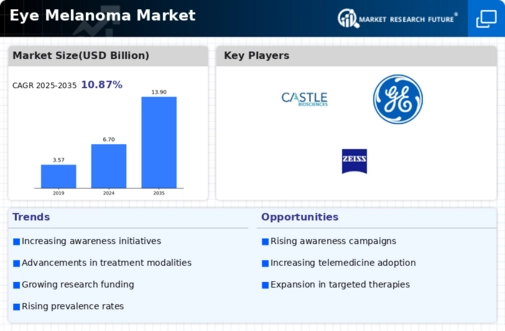Market Growth Projections
The Global Eye Melanoma Market Industry is projected to experience substantial growth, with market value expected to reach 6.7 USD Billion in 2024 and 13.9 USD Billion by 2035. This growth trajectory suggests a compound annual growth rate of 6.86% from 2025 to 2035. Factors contributing to this expansion include rising incidence rates, advancements in diagnostic technologies, and increased awareness among the population. As the market evolves, it is likely to attract investment and innovation, further enhancing treatment options and patient care.
Emerging Treatment Options
The Global Eye Melanoma Market Industry is benefiting from the emergence of novel treatment options, including targeted therapies and immunotherapy. These advancements offer promising alternatives to traditional treatments, potentially improving patient outcomes and survival rates. For instance, the introduction of checkpoint inhibitors has shown efficacy in treating metastatic eye melanoma, leading to increased interest from healthcare providers and patients alike. As these innovative therapies gain traction, they are likely to drive market growth, contributing to the anticipated market value of 13.9 USD Billion by 2035. The ongoing research and development in this area are crucial for future advancements.
Regulatory Support and Funding
Regulatory support and funding for research into eye melanoma are critical factors influencing the Global Eye Melanoma Market Industry. Government initiatives aimed at promoting cancer research and treatment options are likely to enhance the development of new therapies and diagnostic tools. Funding from public health agencies can facilitate clinical trials and accelerate the approval of innovative treatments. This supportive environment is expected to foster growth in the market, with projections indicating a compound annual growth rate of 6.86% from 2025 to 2035. Such backing is essential for advancing the understanding and treatment of eye melanoma.
Growing Awareness and Education
Increased awareness and education regarding eye melanoma are pivotal drivers of the Global Eye Melanoma Market Industry. Public health campaigns and initiatives by organizations are effectively informing individuals about the risks and symptoms associated with eye melanoma. This heightened awareness is likely to encourage more people to seek regular eye examinations, leading to earlier detection and treatment. As a result, the market is expected to experience growth, with projections indicating a compound annual growth rate of 6.86% from 2025 to 2035. The proactive approach to education is essential in combating this rare but serious form of cancer.
Rising Incidence of Eye Melanoma
The Global Eye Melanoma Market Industry is witnessing a concerning increase in the incidence of eye melanoma, which is projected to reach 6.7 USD Billion in 2024. This rise can be attributed to various factors, including increased exposure to ultraviolet radiation and the aging population, as older individuals are at a higher risk. According to health statistics, the incidence rate of eye melanoma has been steadily increasing, particularly in fair-skinned populations. As awareness grows and more individuals seek diagnosis and treatment, the demand for innovative therapies and screening methods is likely to expand, further driving market growth.
Advancements in Diagnostic Technologies
Technological advancements in diagnostic tools are significantly influencing the Global Eye Melanoma Market Industry. Innovations such as high-resolution imaging techniques and genetic testing have improved early detection rates, which is crucial for better patient outcomes. For instance, the introduction of optical coherence tomography has enhanced the ability to visualize tumors in detail, allowing for timely interventions. As these technologies become more widely adopted, they are expected to contribute to the market's growth, potentially increasing the market value to 13.9 USD Billion by 2035. Enhanced diagnostic capabilities may lead to earlier treatment initiation, thereby improving survival rates.













